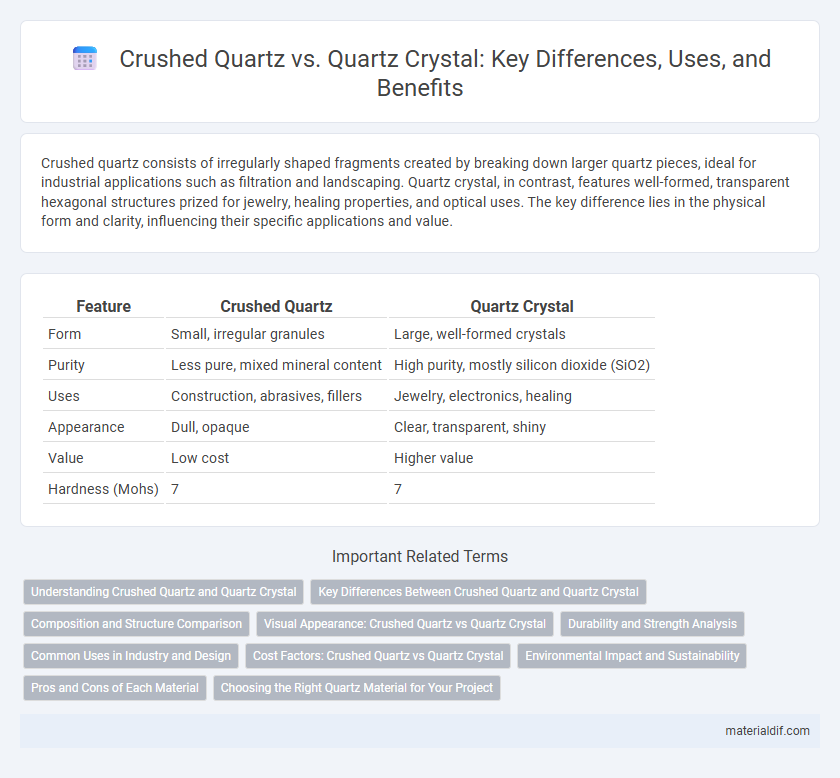Crushed quartz consists of irregularly shaped fragments created by breaking down larger quartz pieces, ideal for industrial applications such as filtration and landscaping. Quartz crystal, in contrast, features well-formed, transparent hexagonal structures prized for jewelry, healing properties, and optical uses. The key difference lies in the physical form and clarity, influencing their specific applications and value.
Table of Comparison
| Feature | Crushed Quartz | Quartz Crystal |
|---|---|---|
| Form | Small, irregular granules | Large, well-formed crystals |
| Purity | Less pure, mixed mineral content | High purity, mostly silicon dioxide (SiO2) |
| Uses | Construction, abrasives, fillers | Jewelry, electronics, healing |
| Appearance | Dull, opaque | Clear, transparent, shiny |
| Value | Low cost | Higher value |
| Hardness (Mohs) | 7 | 7 |
Understanding Crushed Quartz and Quartz Crystal
Crushed quartz consists of fragmented pieces of natural quartz, often used in industrial applications and construction for its durability and abrasive properties. Quartz crystal refers to well-formed, transparent or translucent individual quartz minerals known for their clarity and piezoelectric properties, commonly used in jewelry and electronic devices. Understanding the distinction between crushed quartz and quartz crystal is essential for selecting the appropriate material based on structural integrity and aesthetic requirements.
Key Differences Between Crushed Quartz and Quartz Crystal
Crushed quartz consists of small fragments derived from larger quartz stones, typically used in industrial applications like construction and landscaping due to its rough texture and irregular shape. Quartz crystal refers to natural, well-formed hexagonal crystals prized for clarity, energy properties, and use in jewelry or metaphysical practices. Key differences include particle size, structure integrity, and application scope, with crushed quartz favored for durability and quartz crystals valued for aesthetic and energetic qualities.
Composition and Structure Comparison
Crushed quartz consists of angular fragments derived from larger quartz pieces, maintaining the same chemical composition of silicon dioxide (SiO2) as quartz crystals but differing in physical form. Quartz crystals exhibit a well-defined hexagonal crystalline structure with a uniform lattice arrangement, resulting in their distinctive clarity and shape. The microstructure of crushed quartz lacks the ordered crystal faces found in quartz crystals, affecting its optical properties and surface area.
Visual Appearance: Crushed Quartz vs Quartz Crystal
Crushed quartz features an irregular, fragmented texture with a matte finish, often displaying varied sizes and shapes that create a rough, granular look. In contrast, quartz crystal exhibits a smooth, glossy surface with well-defined geometric facets that reflect light brilliantly, resulting in a sparkling, transparent or semi-transparent appearance. The visual distinction between crushed quartz and quartz crystal is evident in their texture and clarity, with crushed quartz appearing more opaque and rugged compared to the clear, polished aesthetic of quartz crystals.
Durability and Strength Analysis
Crushed quartz exhibits increased surface area and irregular shapes, which can lead to faster wear under mechanical stress but offers excellent compressive strength for industrial applications. Quartz crystal, known for its perfect lattice structure, provides superior durability and higher tensile strength, making it ideal for precision instruments and electronic components. The inherent structural integrity of quartz crystals contributes to better resistance against fractures compared to the fractured edges found in crushed quartz.
Common Uses in Industry and Design
Crushed quartz is widely used in construction and industrial applications such as road building, concrete production, and sandblasting due to its durability and abrasive properties. Quartz crystal is prized in electronics and precision instruments for its piezoelectric qualities, making it essential in oscillators and timekeeping devices. In design, crushed quartz is favored for decorative landscaping and countertops, while quartz crystal is sought after for jewelry and ornamental purposes.
Cost Factors: Crushed Quartz vs Quartz Crystal
Crushed quartz generally costs less than quartz crystal due to its lower purity and simpler processing requirements, making it ideal for industrial and landscaping uses. Quartz crystal, prized for its clarity, size, and aesthetic appeal, commands higher prices influenced by factors such as quality, rarity, and demand in jewelry and electronics markets. The economic disparity between crushed quartz and quartz crystal reflects variations in mining, refinement, and market applications.
Environmental Impact and Sustainability
Crushed quartz and quartz crystal differ significantly in environmental impact and sustainability, with crushed quartz generally requiring less energy for processing due to its naturally fractured state. Quartz crystal extraction often involves more intensive mining operations, leading to greater habitat disruption and higher carbon emissions. Sustainable sourcing of both materials depends on implementing responsible mining practices, minimizing waste, and promoting recycling within the quartz supply chain.
Pros and Cons of Each Material
Crushed quartz offers affordability and versatility in construction and landscaping due to its irregular shape and rough texture, but it may lack the clarity and aesthetic appeal of quartz crystals. Quartz crystals provide superior visual appeal with their natural transparency and well-defined geometric shapes, making them ideal for decorative and metaphysical uses, although they tend to be more expensive and fragile. The choice between crushed quartz and quartz crystal hinges on project requirements, balancing cost-effectiveness and durability against beauty and clarity.
Choosing the Right Quartz Material for Your Project
Crushed quartz offers a versatile material ideal for landscaping, concrete, and abrasive applications due to its granular texture and cost-effectiveness. Quartz crystal, characterized by its clarity and structured crystalline form, is preferred for decorative projects, jewelry, and metaphysical uses where aesthetic and energy properties are important. Selecting the right quartz material depends on the project's functional requirements--opt for crushed quartz for practical, utility-focused needs and quartz crystal for visual impact and specialized uses.
Crushed Quartz vs Quartz Crystal Infographic

 materialdif.com
materialdif.com